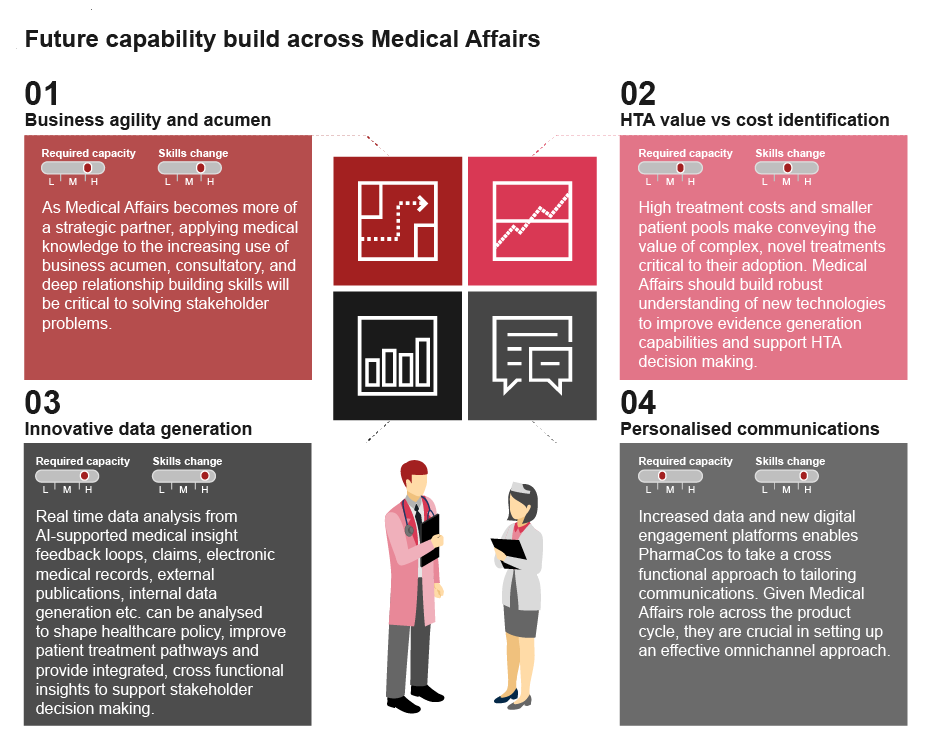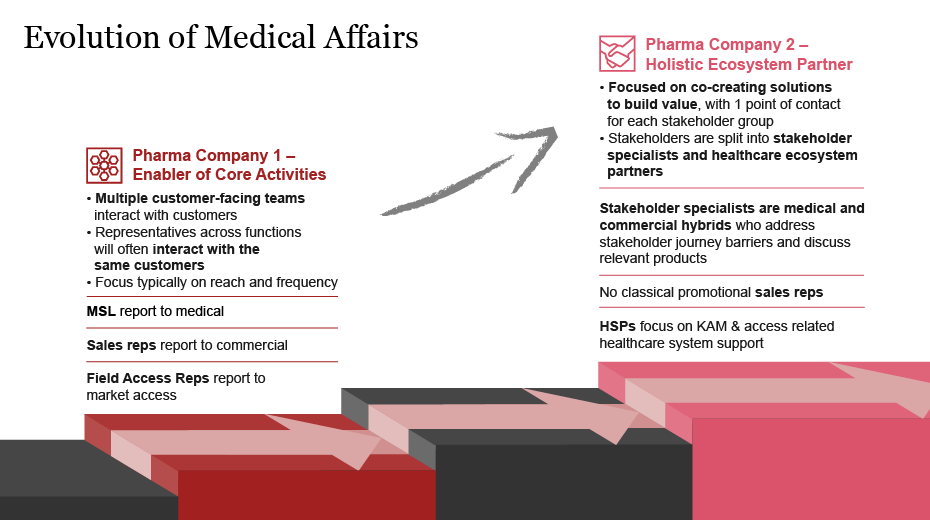More than ever, the Medical Affairs (MA) function is partnering not just with healthcare providers but across functions and with the entire healthcare ecosystem - with patients, patient advocacy groups, key opinion leaders, payers, policy makers and regulators. As MA professionals service new stakeholders, they will need an optimized set of capabilities, including cross-functional, personalized communications, additional sources of insight on new emerging medicines and diagnostics, and patient solutions more tailored to each individual.
MA’s evolving role is complemented by the rise of digitization and the proliferation of data sources. PwC’s report ‘From healthcare to life care: Transforming precision health’ focuses on the current transition from today’s reactive, treatment-based healthcare industry to a system based on the principles of precision health: a proactive, precise, prevention-based life care system enabled by connected stakeholders across the healthcare ecosystem.
To support this transformation, the MA function can introduce its scientific knowledge to stakeholder conversations across the ecosystem, and supplement internal data sources to guide the strategic direction of their organization. However, such an evolution from the traditional role of Medical Affairs, previously limited to the provision of medical information, to an ecosystem partner who makes use of data to solve cross-functional stakeholder pain points and guide enterprise strategy, requires significant advances in capability.
Fueled by all the factors driving the Medical Affairs transformation (Medical Affairs in the Driver’s Seat), we have identified four areas where the function can develop their capabilities and meet future demands:

- Business Agility and acumen – As Medical Affairs becomes more of a strategic partner, combining medical knowledge with business acumen, consultative and relationship-building skills will be critical in solving stakeholder problems.
- Value of Health Technology Assessment (HTA) vs. cost identification – Due to high treatment costs and smaller patient pools, conveying the value of complex, novel treatments is critical to their adoption. MA professionals increasingly need to build a solid grasp of new technologies, such as CAR-T, mRNA and vector therapies, to strengthen evidence-generation capabilities and support HTA decision making.
- Innovative data generation – Real-time data analysis from AI-supported medical insight feedback loops, claims, electronic medical records, external publications, internal data generation and other sources can help to shape healthcare policy through big data insights, improve patient treatment pathways, and provide stakeholders with integrated, cross-functional insights to support decision making.
- Personalized communications – Increased data and new digital engagement platforms enable pharmaceutical companies to adopt a cross-functional approach to tailoring communications. Given MA’s role across the product cycle, the function is crucial to an effective omnichannel approach. Its precise contribution will vary according to particular therapeutic area and relevant stakeholder needs, and will range from condition-agnostic communications to highly specific patient-centric communications, for example with regard to carrier genetic testing (CGT).
To kickstart the function’s evolution, and achieve an understanding of the relative importance of these capabilities, MA first needs to set a vision for its transformation. A transformation may focus on more modest ambitions such as upskilling employees, or call for large-scale investment in new technologies to overhaul the customer engagement model.
- 1Make the current workforce future-proof
Developing talent in lockstep with technological advances is crucial to meet healthcare’s evolving needs. Pharmaceutical companies need to equip MA personnel with the skills to exploit new technology and data sources. In the short term, internal lateral moves and secondments can strengthen cross-regional and cross-functional experience. More training courses should enable MA colleagues to combine their medical and scientific knowledge with an increasingly necessary commercial mindset. A comprehensive upskilling strategy at both the global and local level is vital. - 2Optimize functional capabilities of Medical Affairs
Data and technology can also optimize existing MA capabilities and build new capabilities across the product lifecycle. A few examples include:
- Smarter Medical Insights: It is crucial to develop a cross-functional insights engine strategy for standardized insights generation and a cross-regional AI-supported feedback loop.
- Digital-enabled Evidence Generation: An integrated evidence generation process and framework would enable MA to obtain a holistic view of cross-functional evidence generation needs across therapy areas. MA will be able to expand upstream to support pre-clinical protocol design and use new data to recommend more targeted solutions for specific populations.
- Cross-functional Omnichannel Capabilities: In the future, we expect high-value, personalized scientific exchange, with consistent messaging via advanced tools and technology. Adhering to regulation, scientific communications platforms should be built for cross-functional collaboration to enable consistent and regularly updated medical narrative.
- 3Transform your operating model
Organizations should consider local and even enterprise-level operating model changes. A rapidly changing healthcare ecosystem, with demands from new stakeholders, necessitates change. The scientific understanding of the MA function crucial in developing innovative new operating models.

In markets open to innovation, pharmaceutical companies are developing their customer engagement model to support ecosystem management and maximize patient access to innovative medicines. Multiple customer-facing teams traditionally interact with customers through medical science liaisons (MSLs), sales representatives and, depending on the market, field access representatives. Demands for more streamlined engagement models are leading to hybrid medical and commercial roles that focus on solving pain points in the patient journey.
Brian Selvarajah, Dr. Christoph Gross, Eleanor Craggs and Kevin Kalinka also contributed to this report.
Contact us


